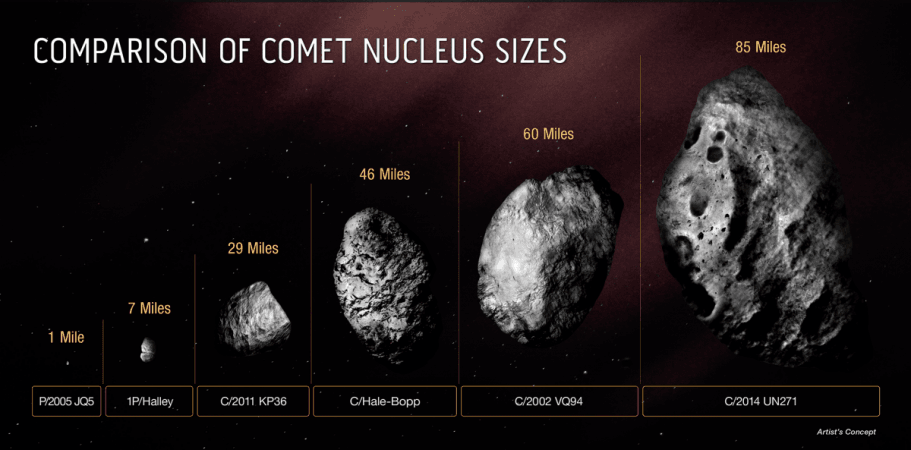NASA's Hubble Space Telescope has determined the size of the largest icy comet nucleus ever seen by astronomers. The estimated diameter is approximately 80 miles across, making it larger than the state of Rhode Island. The nucleus is about 50 times larger than found at the heart of most known comets. Its mass is estimated to be a staggering 500 trillion tons, a hundred thousand times greater than the mass of a typical comet found much closer to the Sun.
The behemoth comet, C/2014 UN271 (Bernardinelli-Bernstein) is barreling this way at 22,000 miles per hour from the edge of the solar system. But not to worry. It will never get closer than 1 billion miles away from the Sun, which is slightly farther than the distance of the planet Saturn. And that won't be until the year 2031.

The previous record holder is comet C/2002 VQ94, with a nucleus estimated to be 60 miles across. It was discovered in 2002 by the Lincoln Near-Earth Asteroid Research (LINEAR) project.
"This comet is literally the tip of the iceberg for many thousands of comets that are too faint to see in the more distant parts of the solar system," said David Jewitt, a professor of planetary science and astronomy at the University of California, Los Angeles (UCLA), and co-author of the new study in The Astrophysical Journal Letters. "We've always suspected this comet had to be big because it is so bright at such a large distance. Now we confirm it is."
Comet C/2014 UN271 was discovered by astronomers Pedro Bernardinelli and Gary Bernstein in archival images from the Dark Energy Survey at the Cerro Tololo Inter-American Observatory in Chile. It was first serendipitously observed in November 2010, when it was a whopping 3 billion miles from the Sun, which is nearly the average distance to Neptune. Since then, it has been intensively studied by ground and space-based telescopes.

"This is an amazing object, given how active it is when it's still so far from the Sun," said the paper's lead author Man-To Hui of the Macau University of Science and Technology, Taipa, Macau. "We guessed the comet might be pretty big, but we needed the best data to confirm this." So, his team used Hubble to take five photos of the comet on January 8, 2022.
The challenge in measuring this comet was how to discriminate the solid nucleus from the huge dusty coma enveloping it. The comet is currently too far away for its nucleus to be visually resolved by Hubble. Instead, the Hubble data show a bright spike of light at the nucleus' location. Hui and his team next made a computer model of the surrounding coma and adjusted it to fit the Hubble images. Then, the glow of the coma was subtracted to leave behind the starlike nucleus.
Hui and his team compared the brightness of the nucleus to earlier radio observations from the Atacama Large Millimeter/submillimeter Array (ALMA) in Chile. This combined data constrains the diameter and the reflectivity of the nucleus. The new Hubble measurements are close to the earlier size estimates from ALMA, but convincingly suggest a darker nucleus surface than previously thought. "It's big and it's blacker than coal," said Jewitt.
















